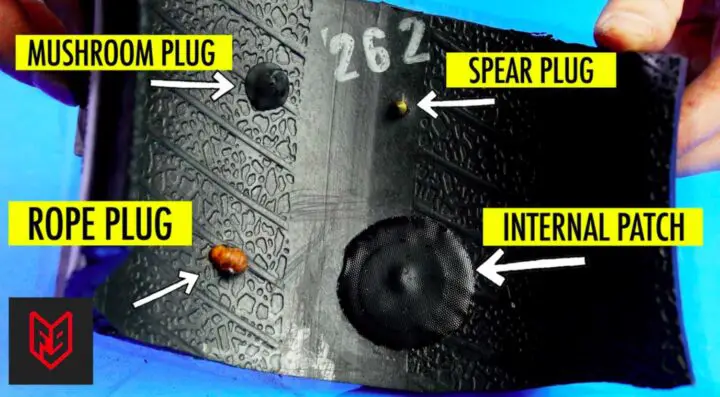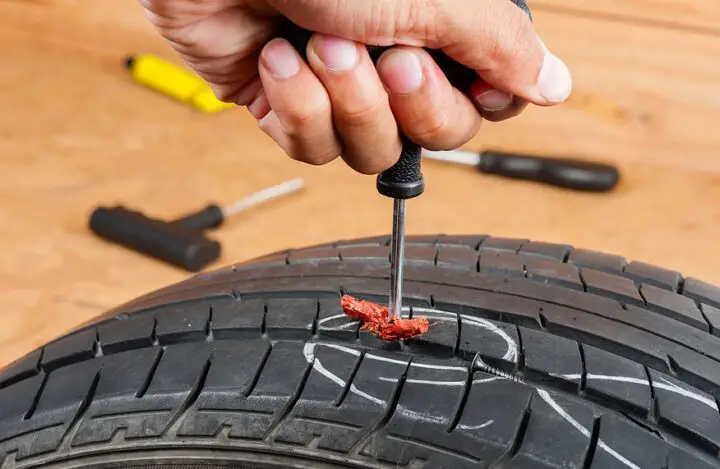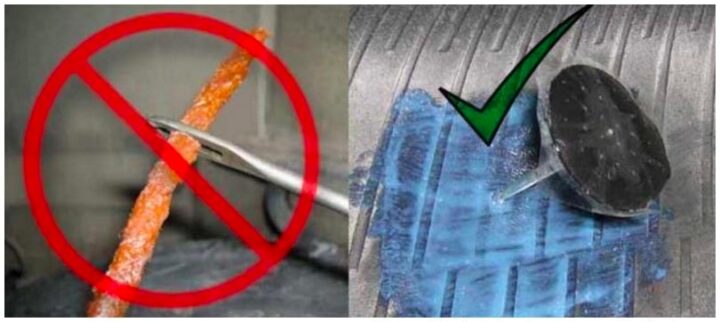
- Yes, a repaired tire can be perfectly safe for a long period of time
- It would be best to patch the inside of the tire
- if you need to simply repair it then go ahead and use either type plug or patch
Related Articles
When Should A Tire Not Be Repaired?
Best Way To Give Someone A Flat Tire
6 Common Causes Of A Flat Tire
What Do I Do With A Flat And No Spare?
I bet you’re wondering, should I plug or patch my tire on my car or truck? Well, let me tell you the advantages and disadvantages of both! On one hand, it’s easier to fix a puncture with a plug because you don’t need any special equipment. All you need is some rubber cement and an air compressor.
You can easily do this without breaking too much of a sweat. However, if your tire has been damaged for weeks and needs more than just a little repair work, then it may be best to invest in getting your tires patched up at the shop. It’s also wise to remember that plugs are only temporary fixes so they won’t last as long as patches will when properly installed by professionals.
Patches have fewer downsides since they can be removed from your tire if it doesn’t hold up. But you’ll need a plugging kit for this type of work and the process is more time-consuming.
So what did we learn? If you’re not sure if you should get a patch or a plug, it’s best to just take your vehicle into a professional tire shop and have them take a look at it for you. They’ll be able to diagnose any problems, help you come up with a solution, install the necessary parts in your tire, and fix anything else that’s wrong!
Table of Contents
What’s The Difference Between Plugging And Patching A Tire
The difference between a tire plug vs patch is the way in which each is installed. Generally speaking, a patch is more of a permanent fix than a simple tire plug repair.
It’s very common for the sidewall of a tire to get punctured with any number of objects: nails, glass, and even road debris such as rocks and potholes can cause damage that prevents air from escaping.
At this point, you probably think “tire repair,” but before you begin tearing out your hair and trying to figure out the best solution (other than buying a new tire) it’s important to understand that there is more than one way of going about repairing a punctured tire.
Let’s start with simply plugging a hole in the tire. A plug is essentially a piece of rubber that is inserted into the tire to seal it off, kind of like inserting a cork into the end of a wine bottle. This type of tire repair works great on small punctures — those less than about 1/4 inch (or 6mm) in diameter.
Tire plugs are also great at stopping slow leaks that sometimes happen after the initial puncture has been repaired. This is because when a hole in a tire gets plugged, it keeps any air from escaping until you can get to the auto shop and buy the necessary tire sealant.

So How Does Plugging Actually Work?
If you’ve ever changed a flat tire on your car, you’re probably already familiar with how it’s done. A tire plug kit consists of a push rod (to be inserted into the tire), rubber or rubber-like string (the plug), and an insertion tool (a small wrench, though in some cases this can be your fingers).
Once everything is assembled, all you have to do is stick the insertion tool into the tire cavity and pull it back out, along with the rubber plug. Insert this plug into the puncture (or another part of the sidewall) and use your finger to smooth it out (the same way you would with caulk or spackle).
All that’s left to do now is insert the pushrod into the insertion tool and push it through the hole. This part will feel a bit weird, but you’ll get used to it after your first plug or two. Once the rod is all the way through, use your finger (or insertion tool) to push some of the rubber “plug” back out of the tire so that there’s enough rod sticking out to grab onto later.
Now all you have to do is push the rod back through the hole until only about 1/4 of an inch is sticking out on each side of your tire. This ensures that it will hold without requiring brute force or long-term exposure to heat, which could potentially cause the rubber plug to dry out and fall out.
Once this is done, just grab the tool you used to insert the plug and pull it back out. Some plugs have a little metal ring sticking through the top that you can also use to help you yank it out — if your plug is one of these then all you have to do is stick a flat-head screwdriver into the end and give it a good tug.
Now that your tire is fixed, for now, you can top it up with air and continue on your way without ever having to worry about flat tires again (unless of course another one gets punctured, which isn’t guaranteed but does sometimes happen).
Getting Your Tire Back Up And Running
It’s important to note that tires do have a “recommended pressure” on them, and it’s a good idea to check this against your car’s tire information before topping up the air. Of course, you should also make sure that the tire is properly repaired before taking off too.
Tire patches are great for large holes that are too complex to plug (or if the plug didn’t work on its own), while tire replacement is the best option for tires that are too old, worn out, or damaged to be repaired. Many newer cars come with tires that have the tire patch already installed inside of them (in a sense), and many more can be patched up after taking off the tire from your car and finding the correct spot on your wheel.
Some of you may know this as the “plug & play” option, which essentially involves pulling out whatever is causing whatever has gone wrong with your tire (such as a nail or screw) and then plugging the hole. This is actually quite an effective method if you can do it yourself since it’s faster than having someone else fix your tire for you.
All in all, there is no single right answer when it comes to tire repair. As we’ve shown here, the best thing you can do is be prepared and know what your different options are in case something happens while you’re out.
The Benefits Of Plugging Your Tire
The main benefit of plugging your tire is that it can be an inexpensive alternative to buying a new tire and it is done in less than 1 hour. With the price of tires these days, you could save hundreds if not thousands of dollars by making your tire(s) last one more year.
The benefits of a tire plug are short. This is generally more of a temporary, rough, and quick fix rather than a long-term forget about it type of repair.
Tire Plug Drawbacks
A plugged tire leaves the original puncture hole inside the tire and can cause leaks over time. It is best to fix the puncture in the tread so that it does not cause problems later on.
The other drawback, although rare, is that if a plug were to come out of the tire, you could have a blowout while driving due to low pressure in your tire. This is the number one reason why we recommend taking your tire to a local tire store and having them plug it you so they can find out exactly where the puncture is located and fix it up.
Every time you drive on your car with a plugged tire it is adding extra wear and tear to the point of contact between the car’s wheel and the pavement below. This can lead to premature deterioration of your tires, leading to having to get them replaced early.
The Benefits Of Patching Your Tire
The main benefits of patching your vehicle’s tire are that it costs less than getting the tire replaced, and also allows you to keep your vehicle on the road for a longer period of time. Instead of having to get your car towed away in order to get the tire repaired or replaced, with patching it is possible to do this right at home or work.
Patch comes with a sealant to cover the punctured area, which protects it from dirt and moisture. This in turn makes the repaired tire last longer before it needs to be replaced. Most experienced mechanics agree that patches yield better results than plugs for most tire issues.
Tire Patch Drawbacks
The main drawbacks of patching your car’s tires are that they are not as strong or durable as tires that have been plugged in, and it can be difficult to find an honest service provider when you need to get your tire patched.
It is more expensive to replace a tire than it is to repair one, so when possible try getting your tire repaired instead of replaced.
It’s better for the environment to try and plug or patch your tire rather than replace it.
Tire plugs are the best choice for repairing large punctures in tires, up to about 3/8 of an inch, because they hold air inside the tire very well.
Should I Plug Or Patch My Tire?
Plugs, when installed correctly and in the right situations, can help a tire last for up to 25,000 additional miles. But while plugs can be effective, usually patches are considered to be the better, more secure option of the two. The patch/plug combo is the safest and most reliable option.
FAQ – Tire Plug Vs Patch
1. How Much Does It Typically Cost To Patch A Tire?
$40 is the average price if you go to an independent garage. Labor should be about 15-30 mins based on $120 per hour, and parts cost should be negligible. Patching a tire costs less than replacing it.
If you do not own a spare tire, the cost of having the plug/patch job done will vary depending on your location; in some cases, it can be free if it is covered under your warranty.
2. How Long Do Tire Repairs Take?
15-30 mins of actual work. Plugging a tire on the side of the road should not take more than 30 minutes for the beginner. If you have the parts and some experience, you should have it done in under 10 minutes.
Patching a tire can take much longer. Waiting at a garage can take a while especially if it is busy. The experienced technician will tell you the estimated time it takes to repair a flat tire. Usually, 15-30 minutes for the actual repair and add on whatever wait time there may be.
3. Is Patching A Tire A Permanent Fix?
A tire patch is only a temporary fix. It will last around 10,000 miles but it might not be reliable at that point. If you do get tire plugged or patched, the technician should tell you how long it will last; if they don’t, find another mechanic to work on your car.
4. Is A Tire Plug A Permanent Fix?
No, a tire plug is a bandaid that lasts a day to a few weeks. Use it to get to a garage to get your tire properly fixed or replaced only. Don’t put a lot of miles on a tire plug or it may lead to more serious and more costly problems in the near future.
5. Can You Patch A Steer Tire?
Yes, you can patch a steer tire. The fixed tire will be weak, however, it is still more durable than a punctured one. A plug on the other hand is much more appropriate for steer tires.
6. Is It Better To Repair Or Replace A Tire?
Replacing a tire that needs to be repaired is the safest choice. If the tire can easily be repaired a patch can add many miles to it. You have to make the decision about where the patch will go to consider replacing or repairing the tire.
Repairing a tire is better for the environment and much cheaper than replacing it, but it may not last as long in some cases.
7. Is A Repaired Tire Safe To Drive On?
Yes, a repaired tire can be perfectly safe for a long period of time. A repaired tire is not as safe as a new one, but it is much safer than a punctured tire.
Make sure you take your tire to a reputable mechanic where they do excellent work. It is worth the extra $10 to get the repair done the right way the first time rather than saving a few bucks to eventually replace your tire.
8. Can You Repair A Tire With A Bolt In It?
Yes, you can repair a tire with a metal object in it. It would be best to patch the inside of the tire where the foreign object has punctured it instead of patching the outside of the tire which is more likely to fail over time, but if you need to simply repair it then go ahead and use either type plug or patch.
9. How Long Can You Drive On A Tire With A Plug In It?
Lots of tire experts agree that you can drive with a plug for about seven to ten years. But you should not aim for this, just to avoid buying a new tire. Since the tire has already been punctured, the tire is at a higher risk of another yet another puncture- causing a blowout. Yes, that plug may last you a few months.

Main Takeaways – Tire Plug Vs Patch
The answer to the question of whether you should plug or patch your tire will depend on many factors, including how long it’s been since you’ve changed that particular tire. If I were in a hurry and needed my car back quickly, then I might opt for a temporary fix with plugs because they are faster than patches.
But if I had time to wait around while someone else fixed my tire so that it was more permanent, then I would probably go with the patched option. This is just one example of why knowing when you need truck tires repaired can be so difficult – there are too many variables!
To help make things easier, our website provides different options based on what type of vehicle you have as well as where exactly the damage has been caused.
In conclusion, it is difficult to decide whether you should repair a tire or replace it because of all the factors involved, but if time isn’t a problem for you and you want something more permanent, then patches are usually the preferred option.
Ultimately though, classifying which option is better depends on your personal preferences and choices as well as the severity of the damage done to your tire.


